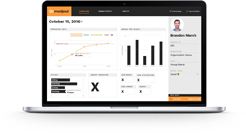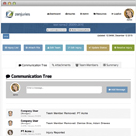Two high-tech solutions for preventing injuries and expediting return to work
Filling out lengthy accident reports … coordinating resources to help injured workers recover … striving to prevent worksite accidents and reduce premiums … these are just a few of the myriad challenges employers face in the complex arena of workers compensation. The burden is even greater for smaller companies, where executives may wear several hats and have no dedicated risk management specialist.
That’s the bad news. The good news is that breakthroughs in technology are enabling employers to tackle these challenges systematically and effectively and to gain control of workers compensation costs while maintaining open communication with their injured workers.
In this article we’ll learn about two exciting new technologies that allow employers of all sizes to monitor and track worker activity and use collected data to implement safe practices and speed the return to work of injured employees.
Wearable tech
First up is Modjoul™, a wearable technology that lets employers gather information in real time about how workers are performing their jobs, with the aim of supporting the employer’s efforts to improve safety and productivity.
Eric Martinez, the founder of Modjoul, possesses both depth and breadth of experience in claims management. He formerly headed AIG’s claims operations,where he reported directly to the CEO, supervised some 25,000 employees, and managed about $40 billion in loss costs. Before that he was head of claims and operations for Safeco.
“Everyone’s struggling to find a way to reduce workers comp claims and losses, and we offer a data-driven solution designed to achieve that result.”
—Eric Martinez
Founder
Modjoul
Martinez left AIG in January 2016 and took some time to consider what new direction to pursue. “I didn’t want to work for a big company again, so I decided to start my own company,” he says. “I visited with some engineering professors I had studied with at Clemson University, explained my idea for Modjoul, and asked them if they thought it was a viable concept. They said yes, and we began to brainstorm what Modjoul would look like.
“The original idea was to design a belt for workers that would reduce strain on the back, but as we proceeded, we realized that, once we built the required infrastructure, the cost of adding more sensors to it would be nominal,” Martinez explains. “The concept morphed into what it is today: a belt with twelve different sensors that track and measure everything an employee does during the day.”
 Modjoul is part of the worker’s normal daily uniform. It looks like a conventional belt; around the belt are the sensors and the battery, and the buckle is the “brain” of the operation, Martinez says. “Wi-Fi and a cell modem are built into the processor; the Wi-Fi connects to the employer’s Wi-Fi. The employee puts the belt on in the morning and wears it all day. There’s a mobile app so he or she can see the data that’s being collected. Modjoul is similar to the Fitbit. It counts not just steps, but how many times the worker bends, lifts, reaches, twists, pulls … all the actions he or she would perform during the day.”
Modjoul is part of the worker’s normal daily uniform. It looks like a conventional belt; around the belt are the sensors and the battery, and the buckle is the “brain” of the operation, Martinez says. “Wi-Fi and a cell modem are built into the processor; the Wi-Fi connects to the employer’s Wi-Fi. The employee puts the belt on in the morning and wears it all day. There’s a mobile app so he or she can see the data that’s being collected. Modjoul is similar to the Fitbit. It counts not just steps, but how many times the worker bends, lifts, reaches, twists, pulls … all the actions he or she would perform during the day.”
The sensors send off a digital signal for every move the worker makes during the day, and a modeling team at Modjoul’s headquarters translates the signals into working verbs. A scorecard displays the information to the employee. Both the supervisor and the risk manager receive data in formats tailored to their respective needs.
The device also monitors the employee for safety. “For example, if an employee is working from height, Modjoul measures the strain being exerted on the back,” Martinez says. “It also records how many times an employee slips, trips, or stumbles during the day. We cover about 75% of the ways employees get hurt on the job. We don’t cover incidents like an employee being crushed by something or being run over by a vehicle or other machinery. The top 50% of the ways employees get hurt on the job are slips, trips, falls, and back injuries.”
Modjoul also tracks an employee’s performance behind the wheel. “It records hard braking, hard cornering, hard acceleration, hard swerving, and how often the driver is exceeding the speed limit by ten miles an hour. It also connects with Google Maps and Waze,” Martinez explains.
Rave reviews
Understandably, Modjoul is a big hit with insurers, agents and brokers, and risk managers. “They love it,” Martinez asserts. “They appreciate the level of detail and the modeling behind the device.
“Employers want their workers to report near misses, but no employee is going to report on him- or herself,” Martinez comments. “Modjoul does all the self-reporting on near misses and actual incidents. When a loss occurs, the risk manager or supervisor pulls data from five minutes before through five minutes after the incident. If someone falls and stays on the floor for a minute or two, because he or she is seriously injured, the data will show that. If the worker gets up and walks away with a limp, that also will be reflected in the data, as will a situation where the worker immediately gets up after a fall and walks away with no problem. This capability eliminates the ‘he said/she said’ conversation that so often takes place after an incident and takes guesswork out of the equation.”
The cost of the Modjoul is $450 per employee, including the data plan. The device is marketed to employers in the hospitality, construction, and manufacturing industries, and Modjoul also is targeting insurers to help them improve their workers compensation loss ratios, as well as brokers and risk management consultants, to provide them a tool their clients can use to create a safer workplace. “Everyone’s struggling to find a way to reduce workers comp claims and losses, and we offer a data-driven solution designed to achieve that result,” Martinez declares.
Managing claims
Next up is Zenjuries™, a web-based software solution that allows agents and employers to track and manage a workers compensation claim after a worker has been injured. As co-founders and co-developers Ben Taylor and Jesse Dantice explain, Zenjuries facilitates a quick and easy three-step process for prompt reporting of claims and ongoing communication with critical team members; the goal is to provide assurance that the company cares about the injured employee and is committed to his or her successful rehabilitation and safe return to work. They note that this can go a long way toward preventing negative feelings on the employee’s part that might give rise to a lawsuit.
Both Taylor and Dantice owned and operated independent agencies until earlier this year, when they sold their firms to Assured Partners. “We both have strong backgrounds in workers compensation, and in 2005 we developed a best practices guide for handling comp claims,” Taylor says. “Jesse and I have collaborated on Zenjuries for the last couple of years, with him serving as lead. I’m also an SIAA (Strategic Independent Agency Alliance) Master Agency principal in South Carolina and Georgia and work with 150 agencies in those states.”
“Zenjuries aims to educate the employer and the employee about the claims process and to help them see workers comp as a benefit, rather than a headache.”
—Ben Taylor
Cofounder
Zenjuries
The best practices guide was the inspiration for Zenjuries, Taylor says. “In the guide, we identified five things an employer can do to help control workers compensation costs. It was well received by our clients and helped us write new business, but because it was a booklet, people tended to drop it into a file cabinet and forget about it. Over time, we produced several versions of the guide and ultimately decided to expand it into a software product, which we called Zenjuries.”
The software is structured to be a simple solution to what most employers view as a complex problem: handling workers compensation claims and managing costs. “Our product is designed to benefit the employer, the employee, the agent, and the carrier, without the interference of plaintiff’s attorneys and the adversarial system that surrounds so many comp claims,” Dantice explains. “Everyone from small employers up to those with thousands of employees is a good candidate for our product, and it’s not industry specific.” Zenjuries is available in formats tailored specifically for many kinds of employers and agencies.
What’s in the box?
Zenjuries provides a step-by-step injury reporting wizard that uses colorful icons, and once a claim has been reported, an instant notification system guides the employer, employee, and agent through each step of the process. Step one is to create a team of people who will be involved in handling and monitoring the claim and communicating with the injured employee. The heart of Zenjuries is a system called the Tree of Communication, which provides a complete history of the life of the claim. Every event, question, comment, and file is organized in chronological order so it can be retrieved and reviewed by anyone on the team.
 “The Tree of Communication is where the magic happens inside of Zenjuries,” Dantice says. “Several critical functionalities are built into Zenjuries to guide the employer, employee, agent, risk manager, HR representative, and other team members through the claims management process. In the Tree of Communication, each member knows what to do and how and when to do it, and each is held accountable for executing his or her tasks. Throughout the life of an injury, certain critical tasks need to be performed, and our system keeps team members on track. The Tree of Communication shows users what was done, when, and by whom, and shows the impact of that action on lowering the cost of the claim.”
“The Tree of Communication is where the magic happens inside of Zenjuries,” Dantice says. “Several critical functionalities are built into Zenjuries to guide the employer, employee, agent, risk manager, HR representative, and other team members through the claims management process. In the Tree of Communication, each member knows what to do and how and when to do it, and each is held accountable for executing his or her tasks. Throughout the life of an injury, certain critical tasks need to be performed, and our system keeps team members on track. The Tree of Communication shows users what was done, when, and by whom, and shows the impact of that action on lowering the cost of the claim.”
The workers compensation system, Taylor notes, is adversarial and often poorly understood by employers. “Zenjuries aims to educate the employer and the employee about the claims process and to help them see workers comp as a benefit, rather than a headache,” he says. “At the time of an injury, the employee is given a list of the expectations he or she can have with respect to how the claim will be handled. The employee knows that, in the event of an injury, the employer and the other team members are going to take care of him or her throughout the process. Whatever the employee needs will be provided, whether it’s an appointment with a physician or physical therapist, a referral, or some other service.”
This kind of open communication, Taylor observes, creates a comfortable environment for the injured employee and greatly reduces the likelihood that, out of fear and frustration, he or she will turn to a plaintiff’s attorney who will sue the employer. Insurers are well aware of the suspicion and hostility that seem to be endemic to the workers compensation system. “The executive of a major insurer once told me, ‘We’ve basically ceded this territory to the plaintiff’s attorneys,’” Taylor says. “With Zenjuries, we can reclaim that territory and create a positive experience for the injured employee.”
Z-Agents
Zenjuries software is distributed through several channels, Dantice says, and it offers agents a special opportunity to provide the product to their clients at a very low cost via a licensing mechanism. A block of pricing plans that range from $25 to $60 per business is available, so that agents can select the number of licenses that best meets their needs.
Also available is a partnership dividend rewards program under which an agent’s small to mid-sized clients can join the Zenjuries group and receive a 5% up-front discount on their comp premium and can potentially qualify for a dividend. The dividend program is currently available in Maryland, North Carolina, South Carolina, Tennessee, Virginia, and Washington, D.C., and coverage is underwritten by Accident Fund Insurance Company of America, a Michigan-based insurer that provides workers compensation coverage in 20 core states.
Modjoul and Zenjuries represent workable, affordable solutions to issues that arise in the challenging arena of workers compensation. While Modjoul’s wearable technology is designed to prevent injuries and claims, Zenjuries software guides all concerned parties through the claims settment process and focuses on maintaining communication with the injured employee. The brave new world of technology is transforming the workers compensation space and improving outcomes for everyone involved.
By Elisabeth Boone, CPCU
For more information:
Modjoul
www.modjoul.com
Zenjuries
www.zenjuries.com






